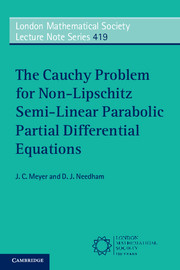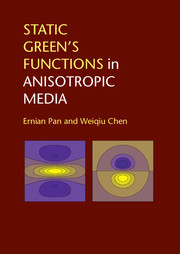Refine search
Actions for selected content:
6993 results in Mathematical modeling and methods
PENETRATION OF SPHERICAL GOLD NANOPARTICLE INTO A LIPID BILAYER
- Part of
-
- Journal:
- The ANZIAM Journal / Volume 57 / Issue 1 / July 2015
- Published online by Cambridge University Press:
- 19 August 2015, pp. 18-28
-
- Article
-
- You have access
- Export citation
DISCRETE SYMMETRIES OF LOW-DIMENSIONAL DIRAC MODELS: A SELECTIVE REVIEW WITH A FOCUS ON CONDENSED-MATTER REALIZATIONS
- Part of
-
- Journal:
- The ANZIAM Journal / Volume 57 / Issue 1 / July 2015
- Published online by Cambridge University Press:
- 19 August 2015, pp. 3-17
-
- Article
-
- You have access
- Open access
- Export citation

The Cauchy Problem for Non-Lipschitz Semi-Linear Parabolic Partial Differential Equations
-
- Published online:
- 05 August 2015
- Print publication:
- 22 October 2015
TRANSMISSION OF ELASTIC WAVES IN ANISOTROPIC NEMATIC ELASTOMERS
- Part of
-
- Journal:
- The ANZIAM Journal / Volume 56 / Issue 4 / April 2015
- Published online by Cambridge University Press:
- 02 July 2015, pp. 381-396
-
- Article
-
- You have access
- Export citation
ANZ VOLUME 56 ISSUE 4 COVER AND BACK MATTER
-
- Journal:
- The ANZIAM Journal / Volume 56 / Issue 4 / April 2015
- Published online by Cambridge University Press:
- 02 July 2015, pp. b1-b7
-
- Article
-
- You have access
- Export citation
KELVIN–HELMHOLTZ CREEPING FLOW AT THE INTERFACE BETWEEN TWO VISCOUS FLUIDS
- Part of
-
- Journal:
- The ANZIAM Journal / Volume 56 / Issue 4 / April 2015
- Published online by Cambridge University Press:
- 02 July 2015, pp. 317-358
-
- Article
-
- You have access
- Export citation
ANZ VOLUME 56 ISSUE 4 COVER AND FRONT MATTER
-
- Journal:
- The ANZIAM Journal / Volume 56 / Issue 4 / April 2015
- Published online by Cambridge University Press:
- 02 July 2015, pp. f1-f2
-
- Article
-
- You have access
- Export citation
HOLDER-EXTENDIBLE EUROPEAN OPTION: CORRECTIONS AND EXTENSIONS
- Part of
-
- Journal:
- The ANZIAM Journal / Volume 56 / Issue 4 / April 2015
- Published online by Cambridge University Press:
- 02 July 2015, pp. 359-372
-
- Article
-
- You have access
- Export citation
A POISSON–PARETO MODEL OF CHLOROPHYLL-A FLUORESCENCE SIGNALS IN MARINE ENVIRONMENTS
- Part of
-
- Journal:
- The ANZIAM Journal / Volume 56 / Issue 4 / April 2015
- Published online by Cambridge University Press:
- 02 July 2015, pp. 373-380
-
- Article
-
- You have access
- Export citation

Static Green's Functions in Anisotropic Media
-
- Published online:
- 05 May 2015
- Print publication:
- 30 April 2015
1 - Introduction
-
- Book:
- Static Green's Functions in Anisotropic Media
- Published online:
- 05 May 2015
- Print publication:
- 30 April 2015, pp 1-28
-
- Chapter
- Export citation
4 - Green’s Functions in Magnetoelectroelastic Full and Bimaterial Planes
-
- Book:
- Static Green's Functions in Anisotropic Media
- Published online:
- 05 May 2015
- Print publication:
- 30 April 2015, pp 111-139
-
- Chapter
- Export citation
Dedication
-
- Book:
- Static Green's Functions in Anisotropic Media
- Published online:
- 05 May 2015
- Print publication:
- 30 April 2015, pp v-vi
-
- Chapter
- Export citation
9 - Green’s Functions in an Anisotropic Magnetoelectroelastic Bimaterial Space
-
- Book:
- Static Green's Functions in Anisotropic Media
- Published online:
- 05 May 2015
- Print publication:
- 30 April 2015, pp 293-327
-
- Chapter
- Export citation
2 - Governing Equations
-
- Book:
- Static Green's Functions in Anisotropic Media
- Published online:
- 05 May 2015
- Print publication:
- 30 April 2015, pp 29-56
-
- Chapter
- Export citation
7 - Green’s Functions in a Transversely Isotropic Magnetoelectroelastic Bimaterial Space
-
- Book:
- Static Green's Functions in Anisotropic Media
- Published online:
- 05 May 2015
- Print publication:
- 30 April 2015, pp 220-259
-
- Chapter
- Export citation
Preface
-
- Book:
- Static Green's Functions in Anisotropic Media
- Published online:
- 05 May 2015
- Print publication:
- 30 April 2015, pp xv-xvi
-
- Chapter
- Export citation
A BIOLOGICAL TREATMENT OF INDUSTRIAL WASTEWATERS: CONTOIS KINETICS
- Part of
-
- Journal:
- The ANZIAM Journal / Volume 56 / Issue 4 / April 2015
- Published online by Cambridge University Press:
- 30 April 2015, pp. 397-415
-
- Article
-
- You have access
- Export citation
Static Green’s Functions in Anisotropic Media - Title page
-
-
- Book:
- Static Green's Functions in Anisotropic Media
- Published online:
- 05 May 2015
- Print publication:
- 30 April 2015, pp iii-iii
-
- Chapter
- Export citation
6 - Green’s Functions in a Transversely Isotropic Magnetoelectroelastic Full Space
-
- Book:
- Static Green's Functions in Anisotropic Media
- Published online:
- 05 May 2015
- Print publication:
- 30 April 2015, pp 176-219
-
- Chapter
- Export citation





